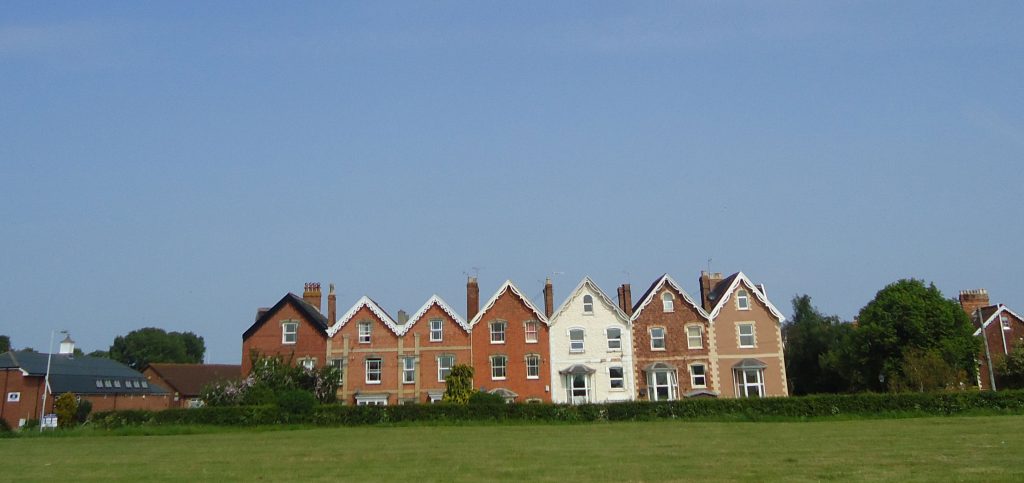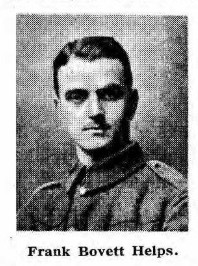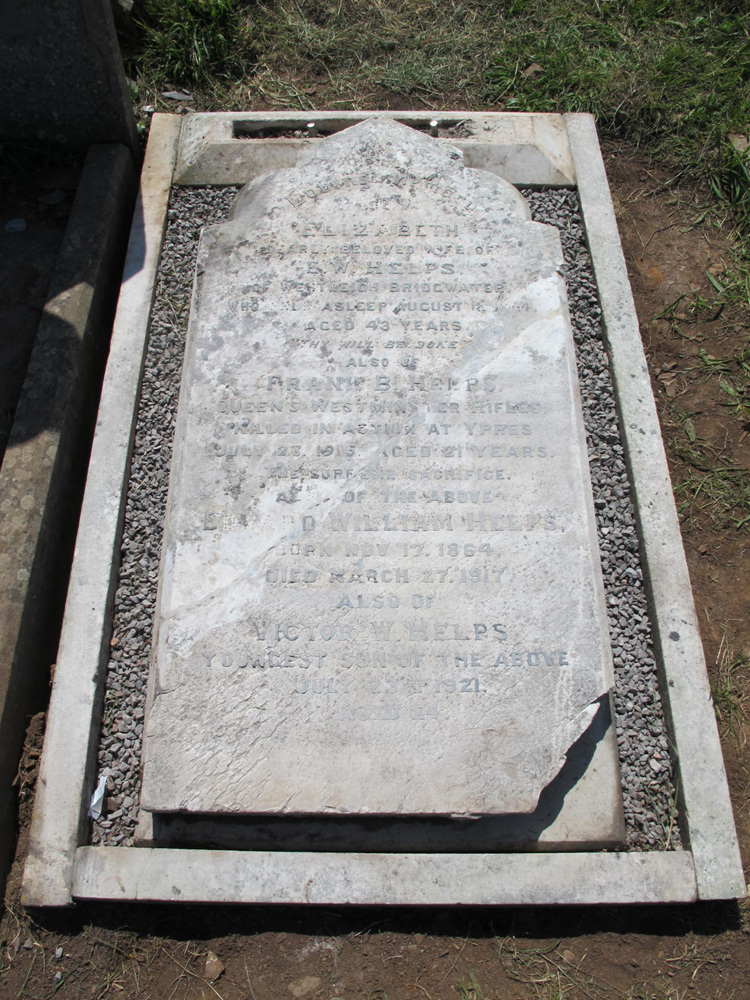Victor William Helps (1897-1921) Lt. Somerset Light Infantry, RAF Pilot and Chartered Accountant.
Victor William Helps volunteered in 1915 before he turned eighteen. He was initially a motorcyclist in the Royal Engineers, but later served as a Lieutenant in the Somersets in India and Palestine. In 1918 Victor was still in Egypt but had become a flying instructor for the newly formed Royal Air Force. He survived the war only to lose his life shortly after in an accident.
Victor’s father Edward William Helps (1863-1917) and brother Frank Bovett Helps (1895-1915) both have biographies on this website.
Early Years
Victor was born on 1 April 1897 in Bridgwater, the youngest of four. He was baptised with his older sister Elsie and brother Frank a month later at St Mary’s parish church. His father Edward was an Incorporated Accountant and his mother Bessie was the daughter of one of Bridgwater’s vets. The family were comfortably off thanks to Edward’s hard work and financial savvy. The children grew up at Westleigh, Durleigh Road, Bridgwater.

One of the major events in Victor’s childhood was the death of his mother Bessie from Addison’s Disease in 1904. Arthur was 13, Elsie 11, Frank 9 and Victor only 7. Both grandmothers were still alive and there were aunts and servants to help look after the children. His father remarried in 1907.
Frank attended Dr Morgan’s school in Bridgwater and then Colchester Grammar School, so Victor probably attended both too. Frank was apprenticed to a draper in Taunton, but when Victor left school in 1912 he began work as a trainee accountant with J. & A. W. Sully & Co, Chartered Accountants, at 19/21 Queen Victoria Street in the City of London.[1] This was the London office of his father’s employer, right in the heart of the world’s most important financial district. In his spare time Victor was a motorcycle enthusiast and in September 1913, surely it was his father who paid £48 for a 1913 Douglas Bros. twin cylinder model, 2¾ HP, with a two speed gear.[2]

At the outbreak of war in August 1914, Frank was working at the department store Bon Marche in Brixton and Victor was still with Sully & Co. The government called on men to fight for their country and Frank enlisted almost immediately. Victor was only seventeen and so too young, but still eager to play his part. Nearly half a million men enlisted in the army in the first few weeks, full of enthusiasm and determination to win the war. The thought of brave deeds and success in battle must have been much more exciting than everyday life in a London office. Christmas 1914 was the last family gathering in Bridgwater before Frank left for France with his regiment.

The War Department had already called for motorcyclists to volunteer with their machines for despatch work and then with Frank going overseas, Victor could not wait any longer. He would have known from talking to his friends that the army wasn’t checking ages. All he would have to do was go to a recruiting depot and pass the medical. Volunteers had to be at least eighteen years old and to serve overseas at least nineteen. Victor, who was seventeen, put his age up by three years for good measure. He was 5’ 9” tall, fit and strong. He enlisted with his motorcycle in the Royal Engineers at Bridgwater and was immediately promoted to corporal. His service record shows that once Victor had finished his basic training, he was a motorcycle despatch rider at home, meaning not overseas. Despatch riders were used to deliver urgent orders and messages between headquarters and military units. Each rider was required to carry a set list of spare parts for his motorcycle at all times. Motorcyclists were paid £10 on enlistment and another £5 on discharge for the use of their machine.

Frank was killed in action at Ypres in July 1915. In his grief, Victor may have been desperate to do more, but his father Edward would have been afraid of losing another son. The compromise was the 1/5 Battalion (Territorial Force), Prince Albert’s Somerset Light Infantry (SLI). The Territorial Force was intended for home defence, but in wartime the regiment’s Territorial battalions were sent overseas for garrison duty, to relieve regular army units that were needed in France. Territorial battalions were recruited locally so there was a good chance that Victor would serve with other Bridgwater men.
Victor was discharged from the Royal Engineers on 15 October 1915 and, with his father’s influence no doubt, commissioned as a 2nd lieutenant in the 1/5 Battalion. This time Victor’s correct date of birth was recorded. There was little time for officer training when the country was already at war. The 1/5 Battalion was already on garrison duty in India and the most likely scenario is that Victor sailed to join them in the next group of reinforcements.[3] Victor’s father Edward died on 27 March 1917, while Victor was still in India. Only his stepmother Emily was still at home in Bridgwater.
In May 1917, the 1/5 was recalled from India and disembarked at Suez, Egypt. The British Army needed more fighting men and so the War Office had given permission for the 1/5 to take a more direct role in Palestine as part of the 233rd Brigade. Two other Bridgwater men serving with the 1/5, Captain Arthur Oswald Major and Sgt Harry Redding, were killed on 23 November 1917 at El Jib during the Battle of Nebi Samwell. Two companies of the 1/5 suffered heavy casualties that day, but the battalion rested, took on reinforcements and fought in Mesopotamia and Palestine for the rest of the war.
Victor was one of many army officers who requested a transfer to the Royal Flying Corps (RFC) which later became the Royal Air Force.[4] Victor already loved motorcycles, so it is no surprise that he took to aeroplanes and flying. His sister Elsie had married a Bridgwater man, Cecil Mackenzie Hill, who was a civilian flying instructor training RFC pilots at Hendon near London. Perhaps Cecil encouraged Victor and gave him his first flying lessons. The RFC had been used to support the artillery with photographic reconnaissance and later with the strafing of enemy positions and strategic bombing. The dogfights with German pilots such as the Red Baron became legendary. Victor may have transferred to the RFC during 1917, as his RAF service record states that since joining the RFC he had flown the following aircraft. However this was dated August 1918 when the abbreviation RFC may still have been in common use.
- Victor trained on biplanes used by the RFC: the DH6 and the Avro.
- he also learnt to fly Sopwith Pups (biplanes), Bristol Scouts (biplanes) and French Nieuport sesquiplane fighters. These three aircraft were all widely used by the RFC.
- he also flew Bristol Monoplanes, which were only used by the RFC in Mesopotamia and Palestine.[5]


The Royal Air Force was formed by the merger of the Royal Flying Corps and the Royal Naval Air Service on 1 April 1918, Victor’s twenty-first birthday. That same day Victor reported to RAF No. 193 Training Squadron at El Amriya, Egypt, near Alexandria. By the end of May 1918 he was qualified on both regular biplanes and seaplanes. Victor remained a lieutenant in the Territorial Force.
At the end of July 1918 Victor was sent to the School of Aerial Gunnery, 5 Fighting School, at Heliopolis, Egypt, as an assistant instructor. In September he had a near miss in his Avro 504A biplane. Victor and his student pilot 2nd Lt R.T. Scott were in the air when the engine’s number 8 cylinder suddenly blew out. Fortunately biplanes could glide and they landed safely.[6] With the war nearly over, Victor was given leave and embarked at Port Said for the UK in October 1918.
The war ended in November, but Victor was transferred to No. 57 Training Squadron at Ismailia, Egypt, on the west bank of the Suez Canal. Egypt had been an important base for the British during WWI but by now the Egyptian people were agitating for independence. There were still many UK civilians and armed forces personnel in Egypt and the Suez Canal was vital to British trade. Victor remained at Ismailia throughout 1919.[7] He was to be promoted to Flying Officer in December 1919, but instead he went on leave for three months, perhaps with a view to sitting the accountancy exams in London. He was back at RAF Ismailia in February 1920. In May 1920 he was flying again in RAF No. 208 Squadron, Palestine Group, at Ismailia. This time Victor flew RE8s and Bristol Fighters. In April and May 1921 he was restored to the active list for training duty. He was finally “dispersed” on 4 June 1921. Victor was awarded the Victory Medal and the British Empire Medal.
Victor returned to Bridgwater. He had passed his final examinations as a chartered accountant and had accepted a job offer in India, for which he was due to sail on Friday 29 July. It was not to be. The following appeared in the Taunton Courier:
“A very sad motor-cycling accident, resulting in the death of a well-known young resident of Bridgwater, occurred on Saturday morning on the Taunton-road near North Petherton. The victim was Mr Victor William Helps, aged 24, a chartered accountant, who sustained such terrible injuries that he succumbed later in the Bridgwater Hospital. On Saturday morning, about ten o’clock, Mr Helps, who resided with his stepmother at 28, Northfield, left Bridgwater to proceed to Taunton to keep a business appointment. No-one saw the accident, which occurred about a mile out from North Petherton, on the main road near the Shearston-lane turning, where, at about 11 o’clock, Mr Edgar Panting of Blackheath London, who was motoring towards Taunton, saw the body of a man lying in the road in an unconscious condition, nearby him in the ditch being a motorcycle. Mr Panting rendered what assistance he could and the unfortunate young man was conveyed to the Bridgwater Hospital in a passing motor car. P.C. Travers of North Petherton arrived on the scene and an examination of the motorcycle revealed that a burst back tyre had been the cause of the accident, Mr Helps being thrown from the machine and sustaining a fracture of the base of the skull. On arrival of the deceased at the hospital he was given every attention, but the case was hopeless from the first and he succumbed to his injuries at about 10.40 on Saturday evening.”[8]
It was exactly six years to the day after the death of his brother Frank in Flanders. The deaths of both Frank and Victor were a great loss to their families and to Bridgwater. Victor is buried in the Wembdon Road Cemetery with his parents. Frank is remembered on the same memorial.

11/220 In Loving Memory of Elizabeth dearly beloved wife of E. W. Helps of Westleigh, Bridgwater who fell asleep August 11th 1904 aged 43 years. Thy will be done. Also of Frank B. Helps Queens Westminster Rifles, killed in action at Ypres July 23rd 1915 aged 21 years. The supreme sacrifice. Also of the above Edward William Helps born Nov. 17 1864 died March 27 1917. Also of Victor W. Helps youngest son on the above July 23rd 1921 aged 24 years.
by Jillian Trethewey and Clare Spicer 2/2/2024
Sources:
Air Force Museum of New Zealand has information about and photos of Cecil Mackenzie Hill. The museum has a website. Home - Air Force Museum of New Zealand
Air History – Royal Flying Corps RFC home (airhistory.org.uk) (accessed Feb 2024). This website has a comprehensive index of names of the pilots and aircrew of the RFC and RAF from 1912 to 1919, taken from official and published records.
British Air Force Lists 1919-1922. National Library of Scotland
British Newspaper Archive
Census records and parish registers.
RAF service record of Lt Victor W. Helps. The National Archives, UK. AIR 76/220/177 (seen on Find My Past website)
Royal Engineers service record of Lt Victor Helps. The National Archives UK. WO 363 (seen on Ancestry.com)
Somerset Light Infantry. The Long, Long Trail website. Prince Albert's (Somerset Light Infantry) - The Long, Long Trail (longlongtrail.co.uk)
Western Front Association. Recruiting and Training the Royal Flying Corps during the Great War. Transcript of an interview with David Spruce. The Latest WWI podcast. Episode 220. (accessed Feb 2024) Ep.220 – Recruiting and training the RFC – David Spruce | The Western Front Association
WWI medal rolls index card of Lt Victor W. Helps. The National Archives, UK. WO 372/9/133101 (seen on Ancestry.com website)
[1] The name of Victor’s employer prior to enlistment is from his RAF service record.
[2] Victor’s Royal Engineers service record regimental number 69040 lists the details of his motorcycle.
[3] The service records of many army officers were lost in a fire during World War II. The service records of officers in the Territorial Forces, if they have survived, are in WO374 in The National Archives, but have not yet been digitised. Other records of the Somerset Light Infantry are in the Somerset Heritage Centre, Taunton.
[4] Victor’s RAF service record states that he learnt French at school and spent two years in France, but without any dates or details. There may have been a clerical error. Victor spent about two years in India and is recorded as embarking in Bombay for Suez in the H.T. Chakdura on 26 Apr 1917.
[5] The aircraft which Victor had flown before he joined the RAF in 1918 are listed on his RAF service record. There are several which suggests that he had been flying for some time. By 1918 the Sopwith Pup and the Bristol Scout biplanes were no longer in service with the RFC, suggesting that Victor learnt to fly in about 1916. His medal roll card lists service in the Somerset Light Infantry and the RFC. His obituary in the Taunton Courier referred to his service in the Somersets and the Royal Flying Corps. It may just be that the abbreviation RFC remained in common use instead of RAF for some time.
[6] Casualty report AIR 1/2045. The National Archives UK. The aircraft was the casualty when repairs took more than 36 hours. There is no report of human casualties.
[7] Victor appears to have been demobilised on paper only in October 1919, four years after he was commissioned in the Somerset Light Infantry. Despite this his service record and the published RAF lists show that he was still at 113 Squadron at Ismailia until May 1920 at least.
[8] Taunton Courier 27 July 1921
